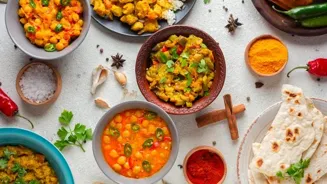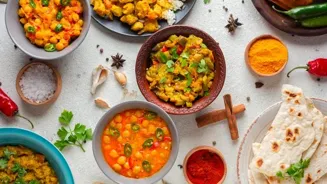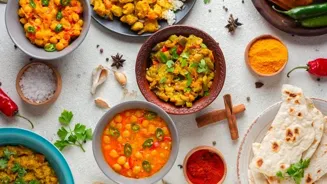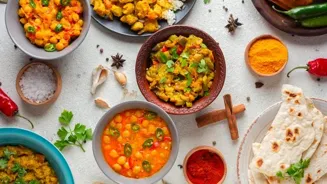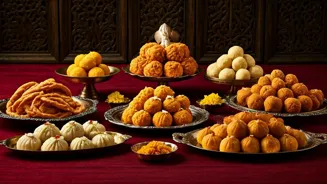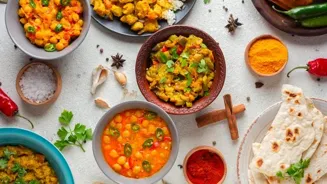Delve into the rich flavors of traditional Indian dishes this festive season! Discover the stories behind these culinary gems
As the festive season paints India in vibrant hues, the air fills with joyous
celebrations and the aroma of delectable traditional dishes. Food is an integral part of any Indian festival, symbolizing prosperity, togetherness, and the rich cultural heritage of our diverse nation.
This year, let's celebrate with these six vegetarian dishes that are sure to add a touch of authentic Indian flavor to your festive gatherings. These recipes are not just about taste; they are about tradition, passed down through generations, each bite carrying a story of our ancestors.
So, gather your loved ones, put on your aprons, and let's embark on a culinary journey through the heart of India!
Modak, a sweet dumpling for Lord Ganesha, symbolizing devotion and tradition
No Ganesh Chaturthi celebration is complete without Modak, the beloved sweet dumpling dedicated to Lord Ganesha. This steamed or fried treat is typically made with rice flour, filled with a mixture of grated coconut, jaggery, and cardamom.
Its unique shape, resembling a closed fist, is said to represent the sweet rewards of hard work and dedication. While the traditional recipe remains a favorite, many modern variations have emerged, incorporating ingredients like chocolate, nuts, and even fruit fillings.
However, the essence of Modak remains the same: a symbol of devotion and a sweet offering to the remover of obstacles. Preparing Modak together can be a fun and engaging activity for the whole family, creating lasting memories and fostering a sense of togetherness during this auspicious festival.
Enjoying a warm Modak straight from the steamer is an experience that truly encapsulates the spirit of Ganesh Chaturthi.
Creamy Payasam: South Indian festive staple symbolizing prosperity and tradition
Payasam, a creamy and comforting rice pudding, is a staple in South Indian festivals, particularly during Onam and Diwali. This sweet delicacy is made with rice, milk, sugar (or jaggery), ghee, and flavored with cardamom, saffron, and nuts.
There are many variations of Payasam, each region adding its unique touch. Some versions include lentils, vermicelli, or even fruits, like banana or mango. Payasam is not just a dessert, it is an auspicious offering made during poojas and celebrations, symbolizing prosperity and divine blessings.
Serving Payasam to guests is considered a sign of respect and hospitality in South Indian culture. The rich aroma and creamy texture of Payasam evoke feelings of warmth and nostalgia, making it the perfect sweet ending to any festive meal.
Sharing a bowl of Payasam with loved ones is a cherished tradition that strengthens bonds and celebrates the spirit of the festival.
Gujiya: Essential Holi pastry in North India, symbolizing joy and celebration
Gujiya, a delightful sweet pastry, is an essential part of Holi celebrations in North India. These deep-fried dumplings are made with maida (all-purpose flour) and filled with a mixture of khoya (milk solids), dried fruits, and nuts.
The crispy outer shell gives way to a sweet and flavorful filling, creating a delightful textural contrast. Gujiyas are often made in various shapes, from the classic half-moon to intricate designs using special Gujiya molds.
Making Gujiyas can be a time-consuming process, but it is a labor of love that brings families together during Holi. The aroma of Gujiyas frying in ghee fills the air, creating a festive atmosphere.
Sharing Gujiyas with friends and neighbors is a cherished tradition, spreading joy and goodwill during this colorful festival. Biting into a warm, crispy Gujiya is like taking a bite of Holi itself - a burst of sweetness and celebration.
Ladoos: traditional Indian sweets enjoyed at festivals and celebrations
Ladoo is perhaps the most ubiquitous Indian sweet, enjoyed during festivals, weddings, and celebrations of all kinds. These round, sweet balls come in a variety of flavors and textures, each region boasting its own unique version.
Motichoor Ladoo, made with tiny droplets of fried gram flour, is a popular choice, while Besan Ladoo, made with roasted gram flour, is known for its nutty flavor. Other variations include Rava Ladoo, made with semolina, and Til Ladoo, made with sesame seeds, often enjoyed during Makar Sankranti.
Ladoos are considered auspicious and are often offered to deities during poojas. They are also a popular gift, symbolizing good luck and prosperity. The simplicity and versatility of Ladoos make them a timeless favorite, enjoyed by people of all ages.
Whether it's a simple Besan Ladoo or a more elaborate Motichoor Ladoo, these sweet treats are sure to bring a smile to everyone's face.
Kheer, a popular Indian rice pudding enjoyed at festivals, symbolizes togetherness and joy
Kheer, a creamy rice pudding similar to Payasam, is a beloved dessert across India, enjoyed during various festivals and special occasions. Made with rice, milk, sugar, and flavored with cardamom, nuts, and saffron, Kheer is a comforting and satisfying treat.
What sets Kheer apart from Payasam is often the cooking method and the subtle variations in ingredients. Some versions of Kheer include condensed milk for added richness, while others use a slow-cooking process to achieve a thicker consistency.
Kheer is often served chilled, making it a refreshing dessert during warmer months. It is also a popular offering during religious ceremonies, symbolizing purity and devotion.
Whether enjoyed as a simple dessert or as part of a grand feast, Kheer is sure to please with its creamy texture and delicate flavor. Sharing a bowl of Kheer with loved ones is a tradition that celebrates togetherness and the joy of simple pleasures.
Shrikhand, a creamy and tangy yogurt dessert, is a specialty of Gujarat and Maharashtra, often enjoyed during festivals like Diwali and Janmashtami. Made with hung curd (yogurt that has been strained to remove the whey), sugar, and flavored with cardamom, saffron, and nuts, Shrikhand is a light and refreshing treat. The process of making Shrikhand involves hanging the yogurt overnight to achieve a thick and creamy consistency. This unique texture is what sets Shrikhand apart and makes it a truly indulgent dessert. There are many variations of Shrikhand, including Mango Shrikhand (Amrakhand) and Saffron Shrikhand (Kesar Shrikhand). Shrikhand is often served chilled, making it a perfect dessert for hot summer days. It is also a popular accompaniment to other festive dishes, providing a refreshing contrast to rich and savory flavors. Enjoying a bowl of Shrikhand is a delightful way to end a festive meal, leaving you feeling satisfied and refreshed.
These six traditional Indian vegetarian dishes are just a glimpse into the vast and diverse culinary landscape of our country. Each recipe carries a story, a tradition, and a sense of belonging. This festive season, take the time to prepare these dishes with love and share them with your loved ones.
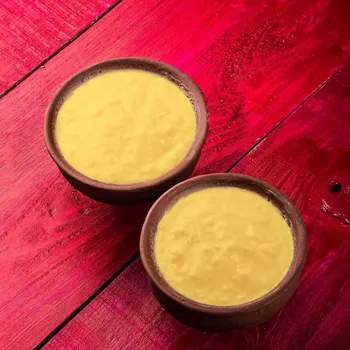
Let the aroma of spices and the sweetness of these treats fill your homes with joy and celebration. After all, food is not just about sustenance; it is about connection, tradition, and the celebration of life itself. Happy festivities and happy cooking!
AI Generated Content. Glance/InMobi shall have no liability for the content
